- Forest fire ecology -
Our planet faces remarkable environmental changes. Specifically there is a growing interest on how these changes affect biota and biodiversity at high elevations and high latitudes. For example, the Intergovernmental panel on climate change (IPCC) has reported that due to the influence of global warming, the quantity of snow at high altitudes is sharply decreasing (IPCC 2007). This is leading to early snow-melt, and longer fire seasons, and may result in more frequent large forest fires at higher elevation areas, such as in western North America (Westerling et al. 2006). Moreover, it is thought that past fire suppression policy has altered forest structures accounting for the considerably larger forest fires recently (Rollins et al. 2001). This knowledge raises questions on how changing climate and land use are interacting and affecting future probability of massive forest fires.
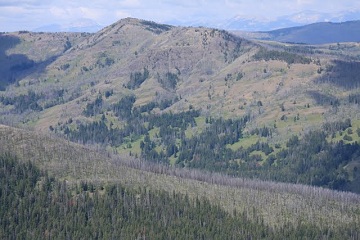
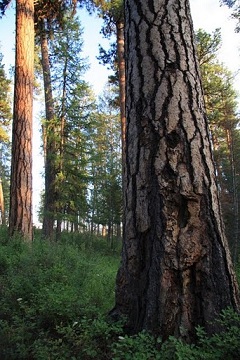
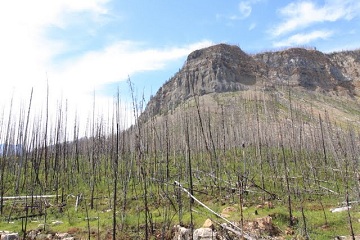
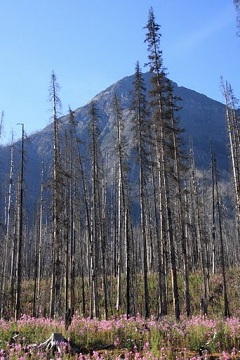
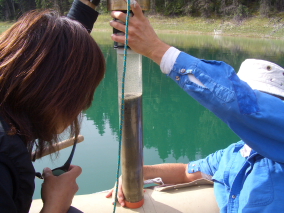
Over the last twenty years, it is in the middle-high elevation areas of the Northern Rocky Mountains in North America where there has been a dramatic increase in the number of large forest fires (Westerling et al. 2006). For example, Kootenay National Park in British Columbia, Canada, had a massive region of its subalpine forest burned in 2001 and 2003. Also Glacier National Park in Montana, US, had destructive forest fires in 2003 and 2006. This kind of unforeseen large forest fire may at first seem catastrophic and devastative, however it may be irrational to immediately assume it is an environmental disaster. Conceivably these enormous events are necessary natural phenomena in the forest ecosystems, which have adapted to infrequent large fires. In other words these "natural disturbances" are an integral part to maintain the integrity of forest ecosystems. It is alarming as excluding these natural events could lead to irreversible changes in ecological function and degradation of biodiversity (Mori 2011a, Mori 2011b).
This is relevant in the Rocky Mountains as they stretch all the way from the US, to Canada, and are home to some of the most precious ecosystems. Including the UNESCO World Heritage Sites, for instance the Yellowstone National Park or the Canadian Rocky Mountain Parks. Because giant forest fires disturb the ecosystem and landscape, the biota included would be affected (Turner et al. 1998). In spite of this seemingly "devastation", in the subalpine area, large forest fires will most likely occur (Schoennegel et al. 2004). It is important to note that forest fires are essential to giving forest ecosystems diversity. However forest fires on an increasing frequency and size could lead to the profound ecological destruction, unless they are natural. The problem is trying to understand if human activity is the cause for a greater amount of fires with this scale and frequency. To shed light on this problem we must attempt to answer some questions, what are the frequencies of massive fires lately that are caused by human induced global warming? What have been the negative consequences of past fire suppression policies? Finally, what is the historical frequency of fires caused by natural disturbances? Lately that is caused by human induced global warming? What have been the negative consequences of past fire suppression policies? Finally, what is the historical frequency of fires caused by natural disturbances?
In my own research, I am exploring the cause and ecological meaning of massive fires that arise in the mountain forest area of the Rocky Mountains. Particularly, I focus on the outcome of human activity on the ecosystem and climate conditions, as well as discovering the frequency and size of fires we are willing to accept. My research sites include Kootenay National Park, British Columbia, Canada, and Glacier National Park, Montana, US. These National Parks are also supporting my research.
In detail, 1) reconstruct the spatial changes of the past forest fires by using Geographic Information System (GIS), and evaluate the influence of the fire suppression policy on those forests, 2) assess the effect that the change in natural climate patterns (e.g. El Niño / La Nina) give on regional climate and forest fire systems, 3) speculate the climate change during the past 1000-2000 years and the frequency of forest fires by using lake sediment data. Through this research, I investigate forest fire systems as natural disturbances (Mori 2011a; Mori & Lertzman 2011).

References
IPCC (2007) Climate Change 2007: The physical science basis: Summary for policymakers.
Mori AS (2011b) Ecosystem management based on natural disturbances: Hierarchical context and non-equilibrium paradigm. Journal of Applied Ecology 48: 280-292.
Mori AS (2011a) Climatic variability regulates the occurrence and extent of large fires in subalpine forests of the Canadian Rockies. Ecosphere 2(1): art7.
Mori AS, Lertzman KP (2011) Historic variability in fire-generated landscape heterogeneity of subalpine forests in the Canadian Rockies. Journal of Vegetation Science 22: 45-58.
Rollins et al. (2001) Evaluating a century of fire patterns in two Rocky Mountain wilderness areas using digital fire atlases. Canadian Journal of Forest Research 31: 2107-2123.
Schoennegel et al. (2004) The interaction of fire, fuels, and climate across Rocky Mountain forests. BioScience 54: 661-676.
Turner et al. (1998) Factors influencing succession: lessons fromlarge, infrequent natural disturbances. Ecosystems 1: 511-523.
Westerling et al. (2006) Warming and earlier spring increase western U.S. forest wildfire activity. Science 313: 940-943.